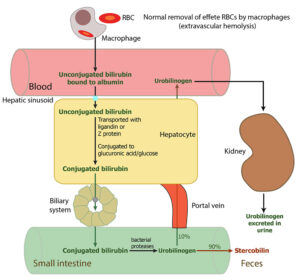Under physiologic conditions, most of the unconjugated bilirubin in blood comes from normal RBC turnover, where RBCs that have completed their normal lifespan (effete) are removed by macrophages in the spleen, liver and bone marrow. Small amounts of bilirubin also come from other heme-containing proteins, such as myoglobin. As RBCs age, they accumulate oxidative injury, which causes exposure of an antigen on RBCs, which is recognized by macrophage receptors, resulting in phagocytosis (extravascular hemolysis) and conversion of the porphyrin ring of hemoglobin into biliverdin and then unconjugated bilirubin (indirect bilirubin on chemistry panels).
Macrophages export the unconjugated bilirubin into blood, where it binds to albumin as it is water insoluble. The albumin-bound unconjugated bilirubin is take up by transporters in the hepatocytes on the sinusoidal (blood or lumen) side of the membrane. The unconjugated bilirubin is transported internally within the hepatocyte by ligandin or Z protein and then conjugated to glucuronic acid (glucose in horses) to form conjugated bilirubin (direct bilirubin on chemistry panels), which is water soluble.
The conjugated bilirubin is then excreted into the biliary system by transporters on the canalicular or biliary side of the membrane (different from those that take up unconjugated bilirubin from blood) along with bile salts and is either stored in the gall bladder (for those species with a gall bladder) or excreted directly into the small intestine. Within the small intestine, the conjugated bilirubin is degraded by bacterial proteases to urobilinogen, around 10% of which undergoes enterohepatic recirculation after uptake by the portal vein. The “reclaimed” urobilinogen is then freely filtered by the glomerulus and is found in urine (there is a pad for urobilinogen on a urinary dipstick but it is not used in veterinary medicine as a diagnostic test). The rest of the urobilinogen is reduced to stercobilin (either directly or via stercobilinogen), which is excreted in the feces. Stercobilin imparts the brown color to normal feces.
The excretion of conjugated bilirubin into bile is the rate-limiting step of the entire pathway of bilirubin metabolism and is ATP- or energy-dependent.

